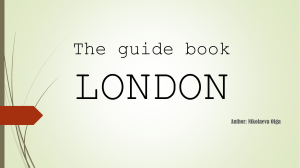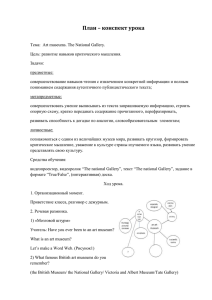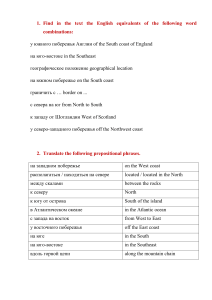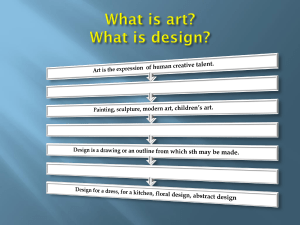Методическая разработка урока английского языка в 11 классе
advertisement
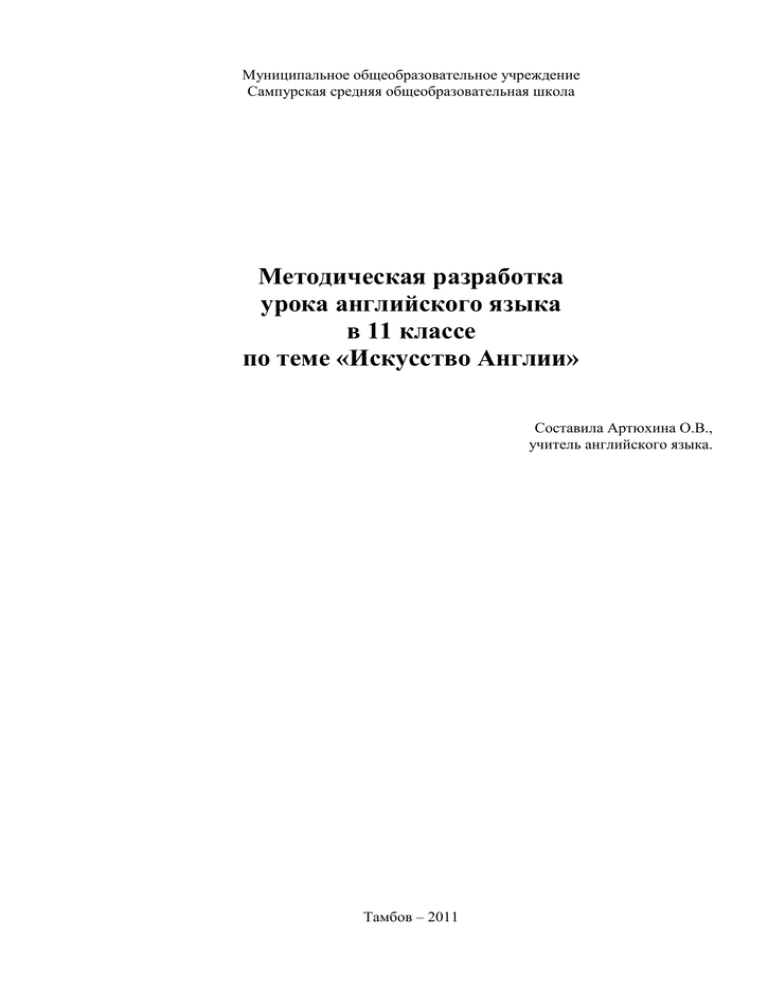
Муниципальное общеобразовательное учреждение Сампурская средняя общеобразовательная школа Методическая разработка урока английского языка в 11 классе по теме «Искусство Англии» Составила Артюхина О.В., учитель английского языка. Тамбов – 2011 Пояснительная записка Обучение ИЯ ориентировано на разностороннее развитие учащихся, их общее образование и воспитание, помогает формировать у учащихся более целостную картину мира, в котором сам ИЯ является средством познания и общения. Процесс обучения ИЯ имеет социокультурную направленность. Широкое привлечение лингвострановедческого материала дает возможность лучше овладеть языком через знакомство с бытом, культурой, традициями и достопримечательностями страны изучаемого языка. Применение на уроках ИКТ повышает интерес учащихся к изучению иностранного языка путем развития внутренней мотивации. А позитивная мотивация – это ключ к успешному изучению иностранного языка. Современные подходы к обучению иностранному языку подчеркивает важность использования компьютера на уроках, а проект – это возможность выразить свои собственные идеи в удобной для детей творчески продуманной форме. В качестве варианта проектной работы можно рассмотреть тему 11 класса «Искусство», при прохождении которой учащиеся могут создать презентации о знаменитых художниках, их творчестве, а также познакомиться с картинной галереей Лондона. Урок содержит видеофрагмент «Национальная галерея Лондона», презентации учащихся по теме «Искусство Англии». Практические задания состоят из заданий на контроль понимания прочитанного и увиденного, отработку лексического материала. В ходе урока используются мини – тесты. Цели: Образовательная цель Совершенствование умений аудирования; Совершенствование умения чтения аутентичного текста; Совершенствование умений монологической речи по теме «Искусство Англии»; Формирование навыков и тренировка употребления грамматических структур so/such/such (a). Развивающая цель Развитие интеллектуальной, речемыслительной, эмоциональной, деятельностной и мотивационной сфер личности обучающихся; Формирование языковой способности в единстве речевосприятия, овладение способами формулирования мысли на иностранном языке. Развитие умений самоконтроля и самооценки. Развитие умений сравнивать культуру своей страны с культурой страны изучаемого языка. Воспитательная цель Воспитание чувств, поведения, в обогащении духовного мира обучающихся; Формирование системы гуманистических ценностных ориентаций. Ход урока: № Коммуникативное задание этапа урока 1. Warming – up 1. Are you fond of paintings? Режим работы T – P1, P2, P3… ИКТ Слайд № 2. 2. Have you ever been to the Art Gallery? 3. Have you ever been to the National Gallery in London? 2. 3. Watching. Listening. 1. Pre-listening: What have you heard or read about the National Gallery of London? 2. Watching. Listening. Now we will watch the film about this gallery. Listen to the guide and translate the story into English. 3. Post-listening: Fill in the table with brief notes from the story: 1. Where is the National Gallery situated? 2. When was it founded? 3. What is the National Gallery noted for? 4. What collections does the National Gallery house? 5. Can you see any works by foreign painters in the National Gallery? 6. Your impressions about the gallery. 7. Are you fond of paintings? 4. What did you like best of all? Reading. 1. Pre-reading: Do you know William Hoggart? 2.Reading: Let`s read the text about him. Then you will answer questions. 3. Post-reading: 1). What is William Hoggart? 2). How did he make his name? 3). What did he paint? 4). What is his famous masterpiece? 4. Task: Translate into English: 1. Хоггарт, один из величайших художников Англии, сделал имя рисуя «разговорные картинки». 2. Люди для Хоггарта – актеры, а картина – сцена. 3. Шедевром «моральных серий» был «Модный брак», изображающий историю брака между молодым лордом и T – P1, P2. Видеофрагмент «Национальная галерея Лондона» Учащиеся смотрят фильм и помечают в тетрадях факты о галерее. Учащиеся заполняют таблицу после просмотра фильма (таблица распечатана для каждого учащегося). После ответа учащихся на каждый вопрос для закрепления показываются слайды. Слайды 3-22. P1, P2, P3… T – P1, P2… Самостоятельная работа учащихся (поисковое чтение). Просмотр слайдов о Хоггарте. Презентация «Художники Англии». Слайды №№ 21-28. дочерью богатого лондонца. 4. Молодой лорд развлекается в плохой компании. 5. Мадам транжирит деньги на аукционах. 6. Слава Хоггарта базируется на этих «моралистических» гравюрах. 4 6. We have read about William Hoggart. What English artists do you know some T – P1, P2, P3… more? Let`s have a rest and see the 3 учащихся presentation of pupils. рассказывают о художниках Англии, остальные учащиеся слушают. Let`s exercise our memory and do the Учащиеся выполняют test. задания после просмотра презентации. Grammar. So, such, such (a). Объяснения учителя. 7. Now let`s check your knowledge. 8. Аnswer the question: What feelings T – P1, P2, P3, … and emotions do the paintings give you? Подведение итогов урока. Домашнее задание. Ex. 5A, 5B, p.61 (WB). 5. 9. 10. Учащиеся выполняют упражнение. Презентация «Художники Англии». Слайды №№ 2-20. Презентация «Художники Англии». Слайды №№ 29-33. Презентация «Национальная галерея Лондона», слайды №№ 25-27. Презентация «Национальная галерея Лондона», Слайд № 28. 1. Warming – up 1. Look at the picture and name the sight of London. (Слайд №2. Национальная галерея Лондона). Answer my questions: 1. Are you fond of paintings? 2. Have you ever been to the Art Gallery? 3. Have you ever been to the National Gallery in London? 2. Watching and Listening 1). Pre-listening: What have you heard or read about the National Gallery of London? 2). Watching. Listening. Now we will watch the film about this gallery. Listen to the guide and translate the story into English. (Просмотр видеофильма о Национальной галерее Лондона). The National Gallery (примерный перевод рассказа о Лондонской Национальной галерее) The National Gallery is situated in Trafalgar Square and is one of the best-known art galleries in the world. It was founded in 1824 and has since become home for London’s splendid collection of roughly 2,300 paintings, which date back from the middle of 13th century to the 19th century. Distinct from Museo del Prado of Madrid and Louvre of Paris, National Gallery was not designed to take over a subsisting royal collection. It started when the British government during that time bought around 36 paintings from John Julius Angerstein. Sir Charles Lock Eastlake, who was one of its primary directors during the olden times, arranged the artworks together with other privately donated pieces. As opposed to other national galleries in Europe, National Gallery London’s collection is rather small in number, but most of it are the important works from noted painters like Giotto down to Cézanne. A visit to this noteworthy destination is free of charge. Meaning you don’t have to spend money to see the famous works of Da Vinci, Van Gogh, Titian, Michelangelo, Botticelli, Raphael, Rembrandt, Monet, Seurat, Caravaggio, Nicolas Poussin, Hans Holbein the Younger, Anthony Van Dyck, Johannes Vermeer, George Stubbs and many other great artists. Popular paintings here include “ The Baptism of Christ,” “The Virgin of the Rocks,” “The Madonna of the Pinks,” “Van Gogh’s Chair,” and “The Rokeby Venus” among others. Indeed, a visit to this gallery would not only leave you awestruck but you will feel like you’re traveling back during the painter’s era. These paintings seemingly come alive as you slowly scrutinize each of them. So for those who love the arts, National Gallery London is the perfect place to go to. When you’re inside the gallery, you’ll feel that as if you are rubbing elbows with the world’s greatest masters of the art. 3). Post-listening: Task. Fill in the table with brief notes from the story. (Слайды №№4-22) Where is the National Gallery situated? When was it founded? What is the National Gallery noted for? What collections does the National Gallery house? Can you see any works by foreign painters in the National Gallery? Your impressions about the gallery. Are you fond of paintings? 4). What did you like best of all? (ответы учащихся). 3. Reading. 1. Pre-reading: Do you know William Hoggart? 2.Reading: Let`s read the text about William Hoggart. Then you will answer questions and do the task after reading. William Hoggart William Hoggart is one of the greatest of English artists of the 18 th century. He made his name as an artist painting “conversation pieces”. These little pictures were very popular in England during the 18 th century. They represented members of the same family or close friends having tea, playing cards, or simply talking to one another. Hoggart said that this picture “ was his stage, and men and women his players”. Later two ideas came to Hoggart`s mind. One idea was to paint moral drama of life in a series of pictures. The second one was to make engravings. His first successful moral series was “The Harlot`s Progress”. It showed a country girl in London. The masterpiece of the series was the famous “Marriage a la` Mode”. This set of pictures describes a marriage between the daughter of a rich man and a young lord, the son of an old Earl. The girl`s father has brought a bag full of money with him. Their children are together but apart: the young man is watching himself in the glass; the girl is listening to a young Counsellor. The pictures round the room help understand the situation. In one of the pictures Madame sits listening to the young Counsellor, whose portrait hangs in her room. Other pictures in the series show My Lord who amuses himself with a bad company. He returns home tipsy. Madame wastes her money at auctions. The end is known. My Lord attacks the Counsellor, who kills him and is executed. Moral: don`t listen to counselors; don`t marry a man for his rank, or a woman for her money; don`t visit auctions unknown to your husband don`t have bad friends. Otherwise you will be ruined. Hoggart`s fame is, in fact, based on these “moral” engravings. They are full of humour. You must read them, and not look at them like other works of art. All through his life, though, Hoggart could also paint pieces of superb painting. (Показ слайдов о творчестве Хоггарта №№ 21-28 из презентации «Художники Англии»). 3. Post-reading: 1). What is William Hoggart? 2). How did he make his name? 3). What did he paint? 4). What is his famous masterpiece? 4. Task: Translate into English: 7. Хоггарт, один из величайших художников Англии, сделал имя рисуя «разговорные картинки». 8. Люди для Хоггарта – актеры, а картина – сцена. 9. Шедевром «моральных серий» был «Модный брак», изображающий историю брака между молодым лордом и дочерью богатого лондонца. 10. Молодой лорд развлекается в плохой компании. 11. Мадам транжирит деньги на аукционах. 12. Слава Хоггарта базируется на этих «моралистических» гравюрах. 4. We have read about William Hoggart. What English artists do you know some more? Let`s have a rest and see the presentation of pupils. (Презентация «Художники Англии»). 3 учащихся рассказывают о художниках Англии (Констебл, Тернер и Гейнсборо). Слайды №№ 2-20. 5. Let`s exercise our memory and do the test. (Учащиеся выполняют задания после просмотра презентации «Художники Англии». Слайды №№29-30). 6. Grammar. So, such, such (a). (Слайды № № 25-27 ). (Учитель объясняет правило употребления грамматических структур so/such/such (a)). So, such, such (a). Can be used with adjectives to add extra intensity. We had such a wonderful weekend! The weekend was so wonderful! Such (a) is used with adjectives before a noun. So Is used with adjectives in the complement of a sentence. Can also be used with adverbs. He sings so clearly. So, such (a) Can also be followed by a that clause. The exam was so difficult that everyone complained. It was such an interesting idea that we all agreed to give it a try. These cases are common in writing as well as speech. 7. Now let`s check your knowledge. (Выполнение учащимися упражнения.Слайд №28 ). Task: Make the sentences more intensive in meaning by adding so/such/such(a) or too to them. 1. 2. 3. 4. 5. 6. I find the picture fascinating. I think it is a remarkable painting. We shouldn`t miss this event. The pines in the picture stand tall and strong. People who have seen the exhibition have different opinions of it. The sky in the picture looks real. 8.. Аnswer the question: What feelings and emotions do the paintings give you? (Беседа по вопросу). 9. Подведение итогов урока. 10. Домашнее задание. Ex. 5A, 5B, p.61 (WB).

